
Everyone wants flawless skin. The Lamprobe is used to remove unsightly and uncomfortable skin tags, skin warts, broken capillaries, milia, acne pimples and DPN – instantly transforming the skin making the difference to all skin types. From light skin to Mediterranean, Asian, Indian and African – All skin irregularities can be cosmetically removed by skin therapists simply, quickly and effectively. Advanced lesions can only be removed by doctors.
Acne Pimples, Actinic/Solar Keratosis, Angiokeratomas, Basal Cell Carcinoma (Dr.), Blind Pimples, Broken Capillaries, Cherry Angiomas, Cholesterol Deposits (Large), Cholesterol Deposits (Small), Clogged Pores, Cutaneous Horn, Cysts, Dermatosis Papulosa Nigra / DPN, Dialated Capillaries, Fibromas, Milia, Moles (Dr.), Molluscum, Contagiosum, Neurofibromas, Pyogenic Granuloma, Raised Angiomas, Sebaceous Hyperplasia, Seborrhoeic Keratosis, Senile Warts, Skin Tag (With Stalk), Skin Tags (No Stalk), Solar Keratosis / Actinic Keratosis, Solar Lentigo, Spider Naevi, Squamous Cell Carcinoma (Dr.), Steatocytoma Multiplex, Syringomas, Telangiectasia, Warts, Xanthelasma
Actinic /Solar Keratosis
These are the most common sun-related pre-cancerous growths noted in fair-skinned individuals. They are benign (non-malignant) and appear as crusty, dry scaly bumps that are rough textured like sand-paper. If left untreated, Actinic Keratosis can develop into Squamous Cell Carcinoma.
Xanthelasma
These are soft yellowish plaques of lipids usually found in the periorbital (around eyes) area. They are very tiny to medium in size and some may be raised. Some individuals are predisposed towards them. They are believed to be related to abnormal lipid metabolism.
Acne/ Blind Pimples/Congestion/Clogged Pores
Acne lesions are caused when the sebaceous glands located near the hair follicle become overactive, inflamed, infected with bacteria and fills up with pus.
Seborrhoeic Keratosis
These are non-cancerous benign skin growths that originate in the keratinocytes of the epidermis. These “barnacles of old age” vary in colour from light to black, are round or oval, slightly elevated and vary in sizes.
Dermatosis Papulosa Nigra (DPN)
These are fibromas that are prevalent in Fitzpatrick Skin Types V and VI (Indian, Asian and African skin tones). These benign lesions are darkly pigmented without scales, and are found most commonly on the face around the eyes, on the cheeks and the neck area. They can appear in adolescence and they increase with age.
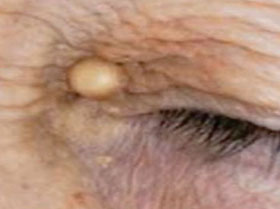
Cholesterol Deposits (Large)
These are soft yellowish deposits of lipids usually found in the periorbital (around eyes) area. They are believed to be related to abnormal lipid metabolism.
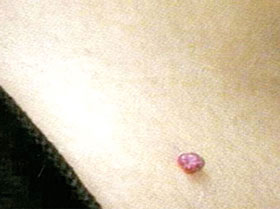
Raised Angioma
These cherry red to purple coloured papules are also known as Campbell De Morgan spots or Senile Angiomas. Clusters of capillaries under the surface of the skin form a flat or raised round dome.
Telangiectasia / Broken Capillaries
Tiny superficial dilated blood vessels appear as red wavy lines just below the surfaces of the skin, mostly on the nose, cheeks and decollete area. Constant blood stimulation causes the thin elastic walls of the capillaries to vasodialate causing breakage. Trauma, lifestyle choices, those who suffer from allergies tend to be prone to Telangiestasia.

Spider Naevus
This is a common benign vascular lesion present in healthy adults and young children. It is characterized by a central red arteriole, or punctum, representing the body of a spider, with radical patterns of thin walled capillaries that look like wavy legs.
Sebaceous Hyperplasia
Chronic sun damage contributes towards these lesions resulting in enlarged sebaceous glands. They appear as a soft, yellowish papule with a cauliflower-like or doughnut-shaped appearance ranging in size from 2 to 3mm. They are usually solitary and appear on the forehead and cheeks, particularly on oily and asphyxiated skins.
Skin Tags
These are small fibromas that appear either single or in multiple formulation and are sometimes referred to as Achrochordon. They are commonly found on the neck, breasts and axillae in skinfolds and on eyelids. They can become inflamed with constant friction from necklaces or clothing.

Skin Tags With Stalk
Although unattractive, these are harmless growths that appear mostly on middle aged men and women. Skin tags are formed when the area of the outer layer of skin begins to overgrow and envelope collagen fibres, protruding from the surrounding skin. They vary in colour and shape and can be irregular.
Cholesterol Deposits (Small)
Tiny cholesterol deposits of lipids are believed to be related to poor lipid metabolism. They are very prominent under the eye and on the nose.

Milia
These plugs of sebum are covered with layers of Stratum Cornified Cells and are commonly found on the facial area where there is poor exfoliation for example on very oily or very dry skins. They can also occur during the healing of traumatic scars. Milia are commonly found on the forehead, cheeks and around the eyes.

Keratoses
These are non-cancerous benign skin growths that originate in the keratinocytes of the epidermis. These “barnacles of old age” vary in colour from light to black, are round or oval or irregular in shape, slightly elevated and vary in size. These are commonly called skin warts, however they do not have a virus present to validate the name.
Cherry Angioma
Also known as Angiomas, Ruby Points, or Blood Spots. These are bright red to purple dots of blood usually found on the upper trunk such as the neck area. In children, they are called Strawberry Hemangiomas and appear raised, red and soft with a strawberry-like lobule but usually disappear in adulthood.
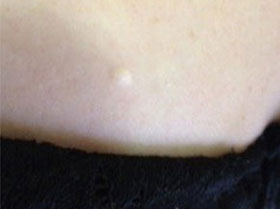
Sebaceous Cyst
A Sebaceous Cyst is a small sac-like bump that contains a jelly-like white or yellow cheesy substance made of keratin. They vary in size and location, can be uncomfortable, unsightly and may or may not become infected. The contents have a foul odour and they can be caused by excessive testosterone levels and other hormonal imbalances in the body. Blocked sebaceous glands can trigger bacterial infections and cause the formation of cysts as well.
Cutaneous Horn (Dr)
These hard conical projections are made up of compact keratin. They can arise from bengin lesions like seborrheic keratosis ostraceouspsoriasis, or hypertrophic lichen planus or from pre-mailignant or malignant lesions like actinic keratosis, intra-epidermal crcinoma,keratoacanthoma, SCC and MM.
Wart
A wart is a local growth of the epidermis caused by a papilloma. Types of warts include: Common wart (verruca vulgaris) e.g. found on hands and top of feet, plantar wart e.g. found on the sole of the foot, genital wart (venereal) e.g. found on the genitals.
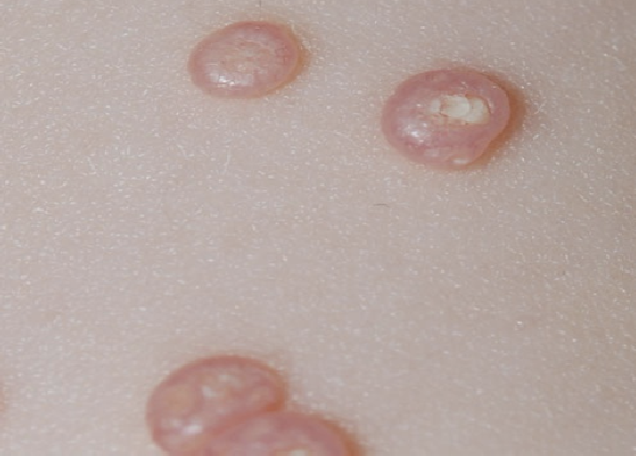
Molluscum Contagiosum
This is a common viral skin infection that causes localised clusters of epidermal papules mainly affecting infants and children caused by a poxvirus. These clusters of small round papules range in size from 1-6mm and are white, pink or brown. They have a waxy, shiny appearance with a central pit and the papule contains a white cheesy substance.
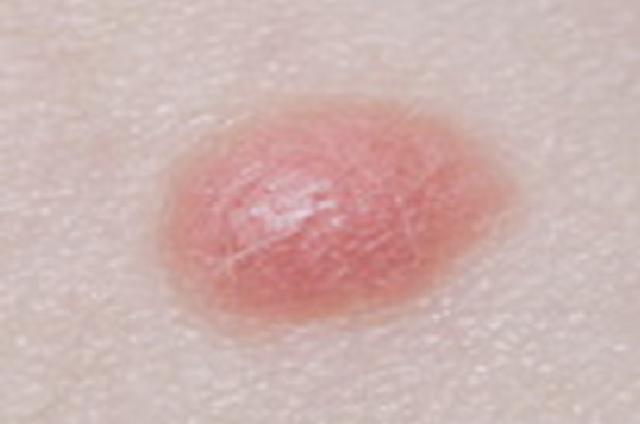
Moles (Dr)
A mole can be a benign or malignant lesion. Moles can be flat or protruding and vary in colour from pink or flesh tones to dark brown or black. Moles appear during the first two decades of a person’s life.
Solar Lentigo
This is a small pigmented macule uniform in colour on the skin, with a clearly defined edge surrounded by normal-appearing skin. A Lentigo has an increased amount of melanocytes, and these can range in colour from light brown to red or black.

Steatocytoma Multiplex
This is an inherited disorder in which numerous cysts appear at puberty due to hormonal stimulus of the pilo sebaceous unit. The cysts tend to be soft to semi-translucent bumps that contain oily, yellow liquid sometimes with a central punctum or without and some may have hairs.
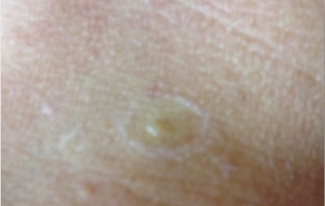
Fibroma
Soft fribromas are benign tumors composed of fibrous or connective tissue and usually have a shaft, however they can be flat and are very common between and under the breast area, and are often found in areas where the skin creases.

Syringoma
A Syringoma forms when there is an overgrowth of cells within a sweat gland duct. The duct becomes enlarged by and clogged with extra cells, forming a hard, round, raised bump about one to three millimetres in diameter that is hard, can be white, yellowish or skin coloured. They are benign, harmless and painless, but unsightly and uncomfortable.

Angiokeratomas
Benign vascular papules. 1 to 5mm in diameter. Red, purple or blue in colour where the surface has become hyperkeratotic overtime. Often located on the scrotum, shaft of the penis, labia majora, inner thigh or lower abdomen. Composed of ecstatic thin walled vessels in the superficial dermis with overlying epidermal hyperplasia.
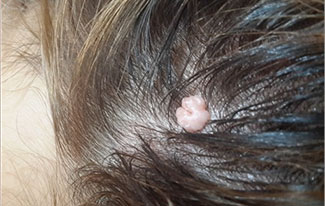
Pyogenic Granuloma
This is a benign, vascular lesion that occurs on both mucosa and on the skin. It is a smooth or lobulated overgrowth of tissue ranging from red/pink to purple, and ranges in size from a few millimetres to centimetres.
| Vascular Lesions | Sabaceous Lesions | Hyperkeratinized Lesions | Some Skin Cancers |
|---|---|---|---|
| Cherry Angiomas | Clogged Pores Acne Pimples |
Actinic/Solar Keratosis Syringomas |
Solar Keratosis(Actinic) |
| Raised Angiomas | Cholesterol Deposits (Large) | Dermatosis Papulosa Nigra (DPN) | Squamous Cell Carcinoma (Dr.) |
| Spider Naevi | Cholesterol Deposits (Small) | Fibromas Senile Warts Moles (Dr.) Warts |
Basal Cell Carcinoma (Dr.) |
| Telangiectasia | Cysts | Neurofibromas | |
| Dialated Capillaries | Milia | Seborrhoeic Keratosis | |
| Pyogenic Granuloma | Sebaceous Hyperplasia | Skin Tags (No Stalk) | |
| Xanthelasma | Skin Tag (With Stalk) |